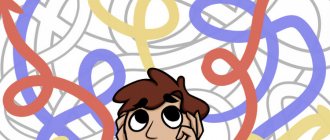Hello, dear readers of the KtoNaNovenkogo.ru blog. Probably most of you have discussed whether your friend or neighbor can be called an intelligent person. After this question, as a rule, a discussion begins, but by what criteria should we judge?
Is a smart person someone who has a lot of knowledge? But he is simply a carrier of information, and may not use it in practice and in life.
When scientists try to define intelligence, they always talk about human cognitive abilities - cognitive functions. What are they, how to develop them, and what to do if they “break down”? We will figure it out and become smarter for our friend.
Cognitive functions, abilities and processes
Cognitive functions are processes in the brain that are involved when we learn about our environment.
The information that comes through our analyzers is processed. We interpret it and translate it into knowledge. They are stored in memory and accumulate over time, becoming life experience.
Cognitive abilities are:
- perception;
- attention;
- memory;
- thinking;
- imagination.
develops throughout his life , then he can be considered smart and intelligent.
Since he is able to perceive information from various sources in large volumes and for a long time; remembers it, reproduces it; draws conclusions; has logical thinking; can imagine the most vivid images based on what he saw or heard.
Theoretical approach[edit]
Cognitivism consists of two main components: methodological and theoretical. Methodologically, cognitivism has a positivist approach and says that psychology can (in principle) be fully explained using the scientific method, there is speculation as to whether this is true or not. [13] This is also a largely reductionist goal, suggesting that the individual components of mental function ("cognitive architecture") can be identified and meaningfully understood. [14] The second says that cognition contains discrete and internal mental states (representations or symbols) that can be changed by rules or algorithms. [15]
Cognitivism became a dominant force in psychology in the late 20th century, replacing behaviorism as the most popular paradigm for understanding mental function. Cognitive psychology is not a complete refutation of behaviorism, but rather an extension that recognizes the existence of mental states. This was due to increased criticism towards the end of the 1950s of simplified teaching models. One of the most notable criticisms has been Noam Chomsky's argument that language cannot be acquired solely through conditioning and must be at least partially explained by the existence of internal mental states.
The main questions that interest cognitive psychologists are the internal mechanisms of human thinking and the processes of cognition. Cognitive psychologists have attempted to shed light on the supposed mental structures that are causally related to our physical actions.
How to develop cognitive thinking
Immediately after birth, the child begins to perceive and explore the world. But he does this at his own level, depending on his age and whether his parents work with him.
There are the following types of cognitive thinking:
- Visual and effective (up to 3 years) - the child looks at everything around him, touches it, sometimes even tries to lick it. That is, it uses all the simplest ways to find out about the objects around it. The role of mom and dad at this stage is to show the child various interesting objects, name them, tell them in an accessible language about their properties and method of use, and let them study it themselves.
- Visual-figurative (up to 7 years) – the child learns to complete assigned tasks and solve problems using logic. Parents should play educational games with him for fine motor skills, memory, attention and imagination. Also teach rules of behavior, which also develops cognitive thinking.
- Abstract (after 7) - the student learns to understand and imagine abstract things (what is this?) that cannot be seen or touched.
But what should an adult do? Is the current level of development of memory or thinking really the limit ? No, even at 40 or 60 years old you can continue to work on your cognitive abilities.
The love of learning about the world around us and ourselves contributes to the improvement of these brain functions.
Some recommendations that are directly aimed at developing thinking :
- Learn a foreign language.
- Choose a different road to get to work or school.
- Do familiar things with your other hand (for right-handed people - left, for left-handed people - right).
- Do crossword puzzles.
- Draw even if you don't know how. Make it more difficult: take the pencils in both hands and continue to draw something.
- Say different words out loud or silently in reverse.
- If you need to calculate simple equations, do it in your head, without the help of a calculator or paper.
- In order to train your memory, before going to bed, you need to remember in detail how the whole day went. You can also reproduce an autobiography from childhood. Or in reverse order: from today until the moment they crawled on the floor for a toy. You can remember either simply in your head, or by telling someone, or writing it down in a notebook.
- Watch various films and read books, of course.
- There are many applications on our smartphones that are directly aimed at developing certain cognitive functions.
Varieties
Now let's figure out what mental processes are.
Basic (lower) cognitive processes
They are presented:
Feeling and perception
We are constantly exposed to various stimuli and signals that make us feel something. Feelings serve as an additional tool for understanding the surrounding reality. Moreover, they can come both from outside and from the depths of ourselves.
Gestalt psychologists, who are engaged in a detailed study of human perception of the world, made a great contribution here. They came up with the laws of Gestalt, which explain the perception of what is happening through optical illusions.
Attention
We live in a world of information and receive many signals and stimuli every day, while paying attention to what we are most interested in.
For a number of activities, such as walking or chewing, we do not need attention. But we will need greater concentration on what we say and how we present it, if, for example, we have to speak in public.
The positive thing is that when certain processes are repeated systematically, they become automatic. For example, if at first it’s difficult for us to drive a car, then later the skills are improved and performed “automatically,” thanks to which much less energy is wasted.
By memory
Our memory stores answers to countless questions that arise in life. It is thanks to it that we encrypt information received from outside and store it so that it can be restored when necessary.
Memory can be of different types: sensory, short-term, working, autobiographical, and so on. All of the varieties interact with each other, but they all originate in different parts of the brain.
Higher (complex cognitive processes)
They are presented:
Mind (intellect)
Intelligence is a set of abilities that help in solving various problems. Nowadays, the most popular theory is about multiple intelligences, which was proposed by Gardner. According to it, there is no one type of mind, and in different situations a person uses different abilities, starting from what is happening.
Smart people have a number of specific identifying characteristics. But intelligence can be improved; there are several methods for this.
Thinking
Human thoughts are incredibly complex and diverse. Thanks to thinking, we can solve various difficulties, reason, make decisions, think creatively, logically, and so on.
To simplify these processes, thoughts with judgments are created in our brain. Our task is to group ideas, objects, people, etc., which has an accelerating effect on mental processes.
But in the desire to achieve logic, a person often forgets about his irrationality. Just think - to speed up thinking we use shortcuts, but in the end we don’t analyze all the information! As a result, cognitive biases and deviations from the norm arise.
Due to cognitive biases, cognitive distortions, negative and irrational thoughts develop, which cause a lot of suffering. For example, “nobody loves me”, “I will always be lonely” and so on.
Fortunately, a person has power over his own thoughts, but not everyone is aware of it and not everyone knows how to use it correctly.
Speech
The human brain reproduces and understands different words, sounds, and combines an innumerable number of letters with sentences to express our thoughts and emotions. Some people speak several languages at the same time (polyglots).
Speech develops and improves throughout life. Although we are all born with different communication skills, they can improve with practice. The latter is especially important for people with speech disorders, because they can also be, if not completely eliminated, then at least reduced.
Cognitive impairments and disorders
The more a person engages in intellectual development, the more connections appear between neurons, which, in turn, also develop. This creates cognitive reserve .
If one part of the brain stops working adequately due to injury or aging, then another will take over responsibility (what is it?) for performing important functions.
An experiment was conducted at Harvard where 824 people were observed over many years. They were of different levels of education, social security and intellectual development.
The result showed that people who actively developed their cognitive abilities were able to think logically in old age, remembered the smallest details, and behaved adequately.
Cognitive disorders are possible for the following reasons:
- injury;
- infectious diseases of the brain itself (meningitis);
- infectious diseases of other systems, in which toxins are released and cells of the nervous system are damaged (syphilis);
- oncological formations;
- diabetes;
- stroke;
- mental illness (schizophrenia);
- aging.
Depending on what caused the dysfunction, there will be different symptoms and cognitive deficits. Let's look at the example of senile and vascular dementia.
Dementia that appears after age 65 is called Alzheimer's disease . The main symptom is the development of forgetfulness. Subsequently, memory deterioration progresses to the point that a person may not remember his name or where he lives. Problems with orientation in space also begin. Therefore, such patients require constant supervision.
Speech is impaired. It is difficult for a person to pronounce words and repeats them. Then there are problems with logical thinking, which are also noticeable when talking with the patient. They become embittered by everything around them, very sensitive and whiny.
Vascular dementia develops due to insufficient blood circulation in the brain, ischemia, and strokes. Memory impairment does not come to the fore as in Alzheimer's. A decrease in attention and concentration is immediately noticeable. Patients have difficulty identifying similarities and differences between objects, slow thinking, and difficulty pronouncing words.
Treatment is prescribed only after a thorough diagnosis of the cause. If this is a consequence of diseases such as infectious diseases, cancer, diabetes, then therapy is aimed at eliminating or correcting the underlying disease.
For Alzheimer's disease, acetylcholinesterase inhibitors are used. In case of vascular disorders, the attention of doctors is aimed at improving blood circulation: phosphodiesterase inhibitors, calcium channel blockers, a2-adrenergic receptor blockers.
In order to improve the state of intelligence in diseases, drugs with metabolic and antioxidant properties are often used. Experiments have also proven the positive effect of nootropics. But it is worth remembering that they only help when there is a problem. Does not improve cognitive abilities in healthy people.
CONTENT
- 1 Cognitive development
- 2 Attention
- 3 How does learning happen?
- 4 What is the role of memory?
- 5 How does the transfer occur?
- 6 What types of learning are explained in detail by this position?
- 7 What are the basic principles of cognitive theory? How do they relate to instructional design?
- 8 How should training be organized?
- 9 Theoretical approach
- 10 Criticisms of Psychological Cognitivism
- 11 See also
- 12 Links
- 13 Further reading
- 14 External links
Cognitive distortions (dissonance)
Cognitive dissonance is not just a fancy phrase that only applies to scientists and professors. We ourselves often encounter this .
This is a state in which contradictions arise:
- knowledge;
- opinions;
- beliefs.
During a cognitive distortion, a person experiences confusion, anxiety, awkwardness, stress, feelings of shame and guilt, or even anger - psychological discomfort . For example, there is a beggar sitting in a pedestrian crossing to whom you gave some money. She reaches for them, and an expensive watch is shown on her hand.
You are confused at first because you thought the person needed financial support. But it turns out that he may be richer than you yourself. At first you find yourself in a stupor, which can then turn into aggression because you have been fooled.
Dissonance (what is it?) arises for the following reasons :
- the discrepancy between a person’s knowledge of an object, phenomenon, other people and really what they are;
- discrepancy between the acquired experience and the situation that was repeated, only in a different way;
- discrepancy between personal opinion and the point of view of others, which pops up randomly;
- maintaining traditions and beliefs, if you yourself do not sincerely respect and believe them;
- logical inconsistency of facts.
What to do if this strange cognitive dissonance happens to you? First you need to reduce the significance of this condition. After all, there is an explanation for everything that is simply not available to you at the moment.
To do this, you need to look for new information about the subject of cognitive distortion . Study it in more detail, or talk about it with other people. Perhaps you just had a small piece of knowledge and this was a great opportunity to expand it.
You shouldn't have very constrained beliefs . You must absorb and notice information of various formats, study everything around you. With this approach to life, it is unlikely that anything will surprise or greatly offend. You will simply stumble upon new knowledge that you will immediately take note of.
What types of learning are explained in detail by this position? [edit]
Cognitive theory primarily explains complex forms of learning in terms of reasoning, problem solving, and information processing (Schunk, 1991). Emphasis should be placed on the fact that the goal of all the above-mentioned perspectives is considered to be the same - imparting knowledge to the student in the most effective and efficient manner (Bednar et al., 1991). Simplification and standardization are two methods used to improve the efficiency and effectiveness of knowledge transfer. Knowledge can be analyzed, decomposed and simplified into basic building blocks. There is a correlation with the behaviorist model of the knowledge transfer environment. Cognitive scientists emphasize the importance of effective processing strategies. [12]
Differences
As stated earlier, any attitude consists of three components, which include a cognitive component, an affective component, or an emotional component. And also behavioral. Essentially, the cognitive component is based on information or knowledge, while the affective component is based on feelings.
The behavioral component reflects how attitudes influence the way we act or behave. This helps to understand their complexity and the potential link between attitudes and behavior.
But for the sake of clarity, keep in mind that the term "attitude" essentially refers to the affected portion of the three components.
See also[edit]
- Cognition - the action or process of knowing
- Cognitive psychology - Branch of psychology
- Cognitive revolution
- Cognitive science is the interdisciplinary scientific study of the mind and its processes.
- Computational theory of mind - Family of views in philosophy of mind
- Consciousness - The feeling or awareness of internal or external existence.
- Critical psychology
- Educational psychology is a branch of psychology concerned with the scientific study of human learning.
- Enactivism is a philosophical concept
- List of important publications in psychology § Cognitive psychology
- Mentalism (psychology)
- Phenomenology - philosophical method and school of philosophy
- Postcognitivism
- Symbol Grounding Problem
Relationship with affectivity
The affective component of a social attitude refers to the emotional aspect of an attitude, which is very often a deeply ingrained element of behavior and most resistant to change. If there are cognitive connections, it is possible to combine two elements and highlight a single cognitive-emotional component.
In simple terms, it includes the emotions felt towards the object of the attitude, say love or hate, as well as dislike, pleasant or unpleasant things. The emotional component, if strong enough, usually stands in the way of attitude change. This component can be explained by this statement: “I like this job, so I will take it.”
Criticism of psychological cognitivism[edit]
| This section requires additional links for verification . |
In the 1990s, various new theories emerged to challenge cognitivism and the idea that thinking can best be described as computation. Some of these new approaches, often influenced by phenomenological and postmodern philosophy, include situated cognition, distributed cognition, dynamism, embodied cognition. Some thinkers working in the field of artificial life (for example, Rodney Brooks) have also created non-cognitivist models of cognition. On the other hand, much of early cognitive psychology and the work of many current cognitive psychologists do not view cognitive processes as computational. The idea that mental functions can be described as patterns of information processing has been criticized by philosopher John Searle and mathematician Roger Penrose, who argued that computation has some inherent shortcomings that cannot capture the basis of mental processes.
- Penrose uses Gödel's incompleteness theorem (which states that there are mathematical truths that can never be proven in a sufficiently strong mathematical system; any sufficiently strong system of axioms will also be incomplete) and the Turing stopping problem (which states that there are some things that cannot be proven. inherently incomputable) as proof of his position.
- Searle developed two arguments. The first (well known from his Chinese room thought experiment) is the "syntax is not semantics" argument, that is, a program is just syntax, and understanding requires semantics; therefore programs (hence cognitivism) cannot explain understanding. Such an argument presupposes the controversial notion of a private language. The second, now favored by Searle but less well known, is his “syntax is not physics” argument: nothing in the world is inherently a computer program except the one that is used, described, or interpreted by the observer, so either everything can be described as a computer and, to put it simply, the brain can, but then this does not explain any specific mental processes, or there is nothing internal to the brain that would make it a computer (program). Many oppose these views and criticize his arguments, which has caused significant controversy. [16] Both points, Searle argues, refute cognitivism.
Another argument against cognitivism is Ryle's regress problem or homunculus fallacy. Cognitive scientists have advanced a number of arguments to try to refute these attacks. [ clarification needed
]
Links[edit]
- Mandler, G. (2002). Origins of cognitive(r)evolution. Journal of the History of Behavioral Sciences, 38, 339-353
- ^ ab Lilienfeld, S.; Lynn, S. J.; Namy, L.; Woolf, N. (2010), Psychology: Foundations of Everyday Thinking
, Pearson, pp. 24–28, ISBN. 978-0-205-65048-4 - General Psychology
(first edition, 2004 ed.). Neelkamal. paragraph 60. - ^ a b c Siegel, L.S.; Morrison, F.J. (December 6, 2012). Cognitive development in atypical children: Progress in cognitive development research. Springer Science & Business Media. ISBN 9781461250364.
- Friedrich, Francis (2019-06-28), "7.2 Attention", Introduction to Psychology
, University of Saskatchewan Open Press, retrieved 2021-03-18. - General Psychology
(first edition, 2004 ed.). Neelkamal. paragraph 59. - ^ a b Pendergast, Donna; Main, Catherine (01/07/2019). Teaching in Primary Schools: Rethinking Curriculum, Pedagogy and Assessment. Allen and Unwin. ISBN 9781760870362.
- Barrouillet, Pierre; Gaillard, Vincian (December 21, 2010). Cognitive development and working memory: A dialogue between neo-Piagetian theories and cognitive approaches. Psychology Press. ISBN 9781136930058.
- "Psychology" (PDF).
- "Teaching Cognitivism".
- "Theories of Learning".
- "Cognitivism Learning and Cognition". Quote journal requires |journal=(help)
- "Cognitivism, psychological glossary, needs, degrees, research, human psychology, articles, approaches, concepts, consciousness". www.psychegames.com
. Retrieved January 29, 2021. - "Components of Cognitive Theory: A Study Guide for the Sciences". canvas.vt.edu
. Retrieved May 15, 2021. - "Cognitivism, psychological glossary, needs, degrees, research, human psychology, articles, approaches, concepts, consciousness". www.psychegames.com
. Retrieved January 29, 2021. - "The Chinese Room Argument", SpringerReference
, Springer-Verlag, 2011, DOI: 10.1007/springerreference_114539










